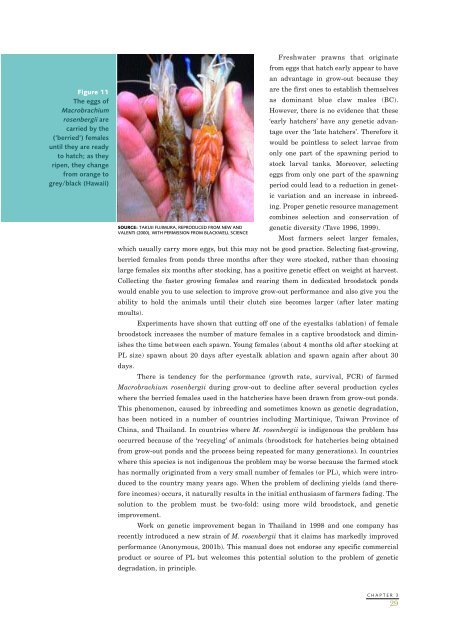You also want an ePaper? Increase the reach of your titles
YUMPU automatically turns print PDFs into web optimized ePapers that Google loves.
Figure 11The eggs ofMacrobrachiumrosenbergii arecarried by the(‘berried’) femalesuntil they are readyto hatch; as theyripen, they changefrom orange togrey/black (Hawaii)Freshwater <strong>prawns</strong> that originatefrom eggs that hatch early appear to havean advantage in grow-out because theyare the first ones to establish themselvesas dominant blue claw males (BC).However, there is no evidence that these‘early hatchers’ have any genetic advantageover the ‘late hatchers’. Therefore itwould be pointless to select larvae fromonly one part of the spawning period tostock larval tanks. Moreover, selectingeggs from only one part of the spawningperiod could lead to a reduction in geneticvariation and an increase in inbreeding.Proper genetic resource managementcombines selection and conservation ofSOURCE: TAKUJI FUJIMURA, REPRODUCED FROM NEW AND genetic diversity (Tave 1996, 1999).VALENTI (2000), WITH PERMISSION FROM BLACKWELL SCIENCEMost farmers select larger females,which usually carry more eggs, but this may not be good practice. Selecting fast-growing,berried females from ponds three months after they were stocked, rather than choosinglarge females six months after stocking, has a positive genetic effect on weight at harvest.Collecting the faster growing females and rearing them in dedicated broodstock pondswould enable you to use selection to improve grow-out performance and also give you theability to hold the animals until their clutch size becomes larger (after later matingmoults).Experiments have shown that cutting off one of the eyestalks (ablation) of femalebroodstock increases the number of mature females in a captive broodstock and diminishesthe time between each spawn. Young females (about 4 months old after stocking atPL size) spawn about 20 days after eyestalk ablation and spawn again after about 30days.There is tendency for the performance (growth rate, survival, FCR) of farmedMacrobrachium rosenbergii during grow-out to decline after several production cycleswhere the berried females used in the hatcheries have been drawn from grow-out ponds.This phenomenon, caused by inbreeding and sometimes known as genetic degradation,has been noticed in a number of countries including Martinique, Taiwan Province ofChina, and Thailand. In countries where M. rosenbergii is indigenous the problem hasoccurred because of the ‘recycling’ of animals (broodstock for hatcheries being obtainedfrom grow-out ponds and the process being repeated for many generations). In countrieswhere this species is not indigenous the problem may be worse because the farmed stockhas normally originated from a very small number of females (or PL), which were introducedto the country many years ago. When the problem of declining yields (and thereforeincomes) occurs, it naturally results in the initial enthusiasm of farmers fading. Thesolution to the problem must be two-fold: using more wild broodstock, and geneticimprovement.Work on genetic improvement began in Thailand in 1998 and one company hasrecently introduced a new strain of M. rosenbergii that it claims has markedly improvedperformance (Anonymous, 2001b). This manual does not endorse any specific commercialproduct or source of PL but welcomes this potential solution to the problem of geneticdegradation, in principle.CHAPTER 329
















